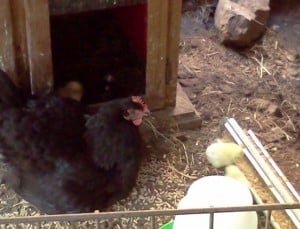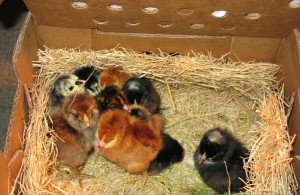First, a few facts to know about chickens:
- A rooster is not needed to produce eggs. The hen already has the eggs. His contribution to the process is to fertilize them. Just like people. Sorta.
- As chicks, they are terribly messy and stinky. They will poop in their food and water, whatever clever contraptions you use to keep them from doing that. They will scratch in their bedding and create a miasma of dust that covers everything in a 15’ radius. I’m not even kidding. Actually, grown chickens are kind of messy, too.
- They are SO CUTE when they’re little. Well, everybody knows that.
- The instinct to hatch eggs has been bred out of most chickens in favor of more egg production. When a hen really decides to set a clutch of eggs, she’ll stay on the nest to the detriment of her own health (and laying capacity). Sitting on a nest like this is called being “broody”.
- Chickens sleep like feathery logs all through the dark hours.
- It’s not that hard to trick a chicken.
Here’s the story:
A couple of years ago, I had two hens that went broody on the same nest. They were sisters and apparently content to sit all cuddled up together (a little unusual, at least for my birds). They’d peck your hand if you were so bold as to try to collect what they perceived in their tiny chicken brain to be their charges. It’s not unheard of for birds to set like that, especially for certain breeds, but all mine had been hatchery chicks and bred for laying, not brooding, so it was pretty cool to see them following that instinct.
Also, it appeared to be a great opportunity to get some new layers without going through the huge PITA of having chicks in the house!
The first attempt was in buying some fertilized eggs. Now, the only way to really tell if an egg is fertilized is to wait til it starts developing a chick and “candle” it to see the shadow inside. Or, I suppose, if you actually see the rooster doing his thing. But generally, eggs are considered “fertilized” if a rooster is run with the hens, as those boys are well known for taking care of their ladies.
It’s a bit sketchy to do it this way. You can’t ever be sure that the hens have enough instinct in them to do all the tasks of hatching their own eggs. They need to keep them at a particular temperature, and roll them over so they’re even and that’s another level of responsibility. Which apparently my grrls weren’t ready for. I think only 1 of the dozen eggs hatched and the rest were duds.
But that didn’t necessarily mean that they wouldn’t be good moms! So following the example of a good friend, who’d gotten his grrls to raise a batch of chicks that weren’t strictly theirs, we let the hens set the nest for a week or two. They’d collected quite a few eggs underneath them by that time and we went about the next phase of our scheme: ordering day-old hatchery chicks.
We received 15 of the little peepers in a few days and right away gave them water and a bit of food. That night (VERY early the next morning, actually) while everybody was asleep, we took the babies out to the coop. Very carefully, we removed the eggs from under the broody grrls and replaced them with the chicks.
Then we waited. And watched. There was always the chance that one or both of the sisters would reject the little ones and we wanted to be able to swoop in and rescue them. You could hear the tiny peeps coming from the box, curious and soft, an answering soft cluck and then quiet as they settled back down.
Daylight came and the moment of truth. It was difficult to see the babies under all the poofed up feathers, but we could hear the conversation beginning. The mamas looked down and all around, fluffing up their feathers, talking to the babies and each other. Instinct took over at that moment, I think, and suddenly all was right with the world.

We set up a barrier to keep the new family separate from the other hens, and in their enclosure, they created a little chicken society. The two hens took turns with the littles, one in the box and one out, watching over the curious babies. You could see the hen telling them what to eat and what not to eat, where to go and not to go. And you could see the chicks listening intently and then mostly doing what they were told.
A really cool aspect of this project was not having to keep those chicks in the house! But even better was watching how the upbringing process worked. The conversations between the mamas and the bebbes were fun to listen to and it was super entertaining to watch their antics. A difficult aspect was that those chicks knew from day one that their place was in the chicken world, skittish and curmudgeonly and unimpressed with my attempts to ‘tame’ them. But like their adoptive moms, what they were good at, they were really excellent at: laying big beautiful delicious eggs!












